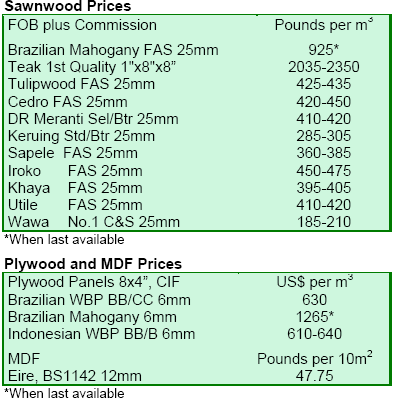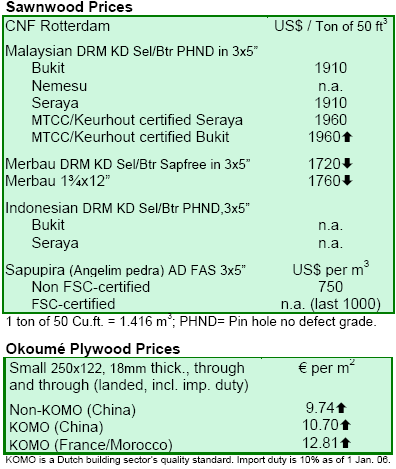Report from the UK
House
builders upbeat amid robust economy
The UK economy grew faster than originally estimated in the first quarter of the year
according to the Office of National Statistics. Boosted by higher business activity, the
economy grew 0.7% compared with the last three months of 2005 and by 2.4% on the year
earlier. The balance of payments gap also fell. A key index of factory activity has grown
at the fastest pace for nearly two years in June. This has increased pressure on prices
and on the likelihood of the Bank of England raising interest rates.
House prices fell unexpectedly by 1.2% in June according to Halifax, UK¡¯s
biggest mortgage lender.
Mortgage debt has gone through the ? trillion level according to the Bank of England, but
the volume of
unmortgaged property is much higher at about ?.6 trillion. Overall, nonetheless, UK house
prices rose 2.6% on average during the second quarter of 2006.
House builder George Wimpy has revealed total group completions for the first half of 2006
rose 29% to 7,822 units, the highest in 25 years. Buyer confidence has improved over 2005
but prices remain competitive. Forward orders were up, both in value 8% and volume 1%.
These sentiments were echoed by many other builders, but costs are rising. Manufacturing
industry¡¯s fortunes are also picking up. The Purchasing Managers survey was at
its strongest level for two years.
In contrast, ¡®Floors to Go¡¯, the largest laminate and wooden
flooring retailer in the UK, has warned that full year prospects are likely to be below
expectations after suffering a further sales slide. Sales in the second quarter of 2006
were down 8.6% as total sales fell by 2%. The market was described as difficult.
TTF brands PNG and Solomon timber as ¡”ćhigh risk¡”Ą
The Timber Trade Federation (TTF) has told its members that sourcing wood products made
from timber from PNG or the Solomon Islands was ¡”ćhigh risk¡”Ą. The
announcement followed an investigation by TTF into Greenpeace¡¯s last year
allegations that PNG-sourced bintangor face veneers on Chinese plywood were illegal. TTF
said that in the absence of credible evidence of legality, products made from wood from
these countries had to be considered high risk and advised its members to avoid them. TTF
added that the current situation in PNG and the Solomon Islands meant there was very
little or no material meeting the environmental standards which the UK market requires.
Chinese ply expands market share in the UK
UK imports of Chinese plywood jumped 20% to 29,800 m3 in the first quarter of 2006,
compared with the same period in 2005, according to Timbertrends. Malaysian imports rose
slightly 2.2% to 34,700 m3. Conversely, UK imports of Brazilian hardwood plywood dropped
35% to 27,000 m3 while Indonesian plywood imports plummeted over 42% to 13,500 m3 in the
same quarter.
Aggregated UK plywood imports from these four supplier countries declined 15% to 105,000
m3 in the first quarter of this year. The decline was due to crackdown on illegal logging
in Indonesia and Brazil, strikes in Brazil¡¯s Ibama and raw material shortages
in Southeast Asia. UK buyers were also holding back purchases hoping for prices to fall.
Despite environmental pressures from NGOs, experts anticipate increasing import volumes of
Chinese plywood in the UK, including products such as door skins and film-faced ply.


Report from Netherlands
Vivid
demand stays as summer vacation begins
Now that the summer-vacation period has started, there has been an obvious decline in
trade activities in the Dutch timber market. Nevertheless, the impression is that,
contrary to previous years, some good demand will still remain, simply due to the fact
that end users are enjoying well filled order portfolios and ample work throughout the
year thanks to active housing market and building activity. Therefore, analysts predict a
quiet spell for several weeks until early September but not a complete standstill as in
earlier years.
The demand for tropical hardwoods, regardless of origin, remains very good while supply is
limited. The whole range of sawnwood sizes, from strips to 3x5¡”Ą and 4x5¡”Ą,
from meranti to sapele, is in keen demand. Fresh quotations of Brazilian sapupira are
increasingly hard to obtain while those of FSC certified material are not available at
all. Prices for all timber (including softwood) both free-delivered buyers¡¯
yard and CNF Rotterdam continue moving upward.
Thanks to the higher sales prices and the vivid demand, some traders have already reached
the same turnover in value or volume as in the whole 2005. The second semester of the year
looks equally promising. Traders, however, hope that the market does not overheat and
prices do not escalate further, since it may force buyers to look for alternatives.
Perhaps the holiday-season may contribute to a stabilization of the market.
NTTA highlights timber procurement policy
At a recent seminar in Kuala Lumpur on timber market changes in Europe, Mr. Paul van den
Heuvel of the Netherlands Timber Trade Association (NTTA) outlined the association¡¯s
timber procurement policy objectives by 2009 as follows:
? Origin of all timber products imported and traded by NTTA members must be known.
? 75% of all timber imported and trade by NTTA members should originate from proven
sustainable
managed forests.
? 100% of the softwood imported by members should originate from proven sustainably
managed forests.
? 50% of the tropical hardwood imported should be proven legally produced, while 25% of
all hardwood
should originate from proven sustainably managed forests.
? 75% of the imported panel products should originate from proven sustainably managed
forests.

Wijma
uses FSC-certified African timber
The Dutch group Royal Wijma, which holds an FSC certified forest concession in south
Cameroon since late last year (see TTM 10:20), has been implementing construction work in
Europe using certified African timber. This includes 70 m?of certified azob”§¦
(ekki) for a new roller-coaster "Deep in Africa" in Phantasialand, Germany with
7 bridges built in a traditional African way; 1,000 m3 of certified bangkirai decking for
balconies of luxury apartments in Switzerland; the world¡¯s first bridge made
of certified azob”§¦ in Kampen, the Netherlands; and the renovation of a sea dyke
and promenade in Oostende,
Belgium using 275 m?of mainly certified azob”§¦.

”” |